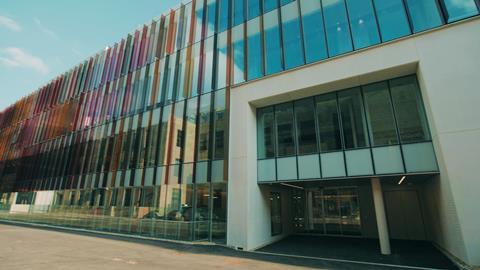Government has set out an ambitious 10-year strategy but there are barriers that could put a brake on developing these high-tech facilities
With life sciences identified as one of the most valuable and strategically important industries for the UK economy’s future growth, the government has now published its 10-year strategy for the sector - Life Sciences Vision.
The collaborative paper, co-authored by government, the NHS, academia and pharmaceutical companies, details the key strategic components it believes will place the UK at the forefront of solving some of the biggest global healthcare challenges.

The role of the NHS is central to the government's vision: first as a huge data lake, providing a wealth of patient data and second as a conduit for clinical trials and feedback data. The NHS will have a new remit to develop national research capability.
Early stage intervention has the explicit aim of creating opportunities to develop early stage treatment and intervention geared around the deployment of genomics and big data, with the development of drugs and vaccines to prevent or treat in the early stages of illnesses ‚Äď imagine being able to vaccinate those deemed most at risk of cancer for example.
In terms of finance, the government is making ¬£1bn of available to address the status quo ‚Äď currently life sciences companies in the UK struggle to find initial public offerings or other late stage funding. This is partly because drug development, for instance, takes time and is therefore capital intensive, needing long term finance to grow.
Speed of regulatory approval is also related to finance ‚Äď it will grant faster returns to investors, hopefully increasing investment and reducing the cost of finance. The government's vision sets out an integrated multi-agency approach, geared around the use of technology and big data. Key to this is the establishment of the integrated licencing and access pathway, which aims to increase speed to market for new drugs.
> Also read: Cost model on Life sciences buildings
> ļ√…ęŌ»…ķTV Boardroom interview with Bruntwood SciTech‚Äôs Peter Crowther
The strategy envisages the use of the UK‚Äôs new immigration system to attract global talent, as well as strengthen and develop the links between universities and industry. A further part of this is developing ‚Äúclinical entrepreneurs‚ÄĚ, who specialise in running life science businesses, as well as developing life sciences apprentices via training and development among school leavers.
Other key elements of the paper relate to the government’s levelling up agenda. It envisages the creation of hubs in the north of England, looking at Liverpool as a potential centre for diagnostic medicine, and Manchester as a hub for genomics. Also singled out is the development of manufacturing capability, building on infrastructure already created during the pandemic and the commitment to transition to net zero. This capability includes creating a tax environment that stimulates investment, with the potential to create manufacturing clusters.
It may be that the sector will become a demand driver analogous to the financial sector during the early 2000s, when the rapid expansion of the city during the late 90s and early 2000s drove huge commercial real estate development in the City and Canary Wharf
But what are the implications for construction? What part will construction play in developing new life sciences assets across the UK?
The green shoots of this strategy are already visible, with both traditional and new market entrants looking to develop new life sciences assets, particularly in London’s King’s Cross, with its access to existing research and health facilities - UCL, UCLH and the Francis Crick Institute to name a few.
is aimed at exponential growth within the sector, particularly with the enhanced capital flows, potentially meaning expansion in the number of companies needing laboratory, office and ancillary space to support their business activities. It may be that the sector will become a demand driver analogous to the financial sector during the early 2000s, when the rapid expansion of the city during the late 90s and early 2000s drove huge commercial real estate development in the City and Canary Wharf.

But there are potential barriers to growth of this scale: it is people that drive real estate demand, and there is still much work to do in terms of aligning the resource pool and capability to enable the development of drugs and vaccines. Also, there is the impact that post-covid working practices might have on space, potentially slowing the rate at which expanding companies require built assets.
Another key component to the strategy is manufacturing, meaning the potential for increased production and manufacturing facility demand. However, it should be noted that demand for these facilities stems predominantly from the drug development pipeline, so again, very much dependent on the pace of development.
Those who time their entry into the market well are likely to benefit and this means an intelligent judgement call around the sort of assets to be developed
The Life Sciences Vision represents a step change in growth and development of the UK‚Äôs life sciences sector aiming to provide the industry with the platform for rapid growth. This represents a different approach to industrial strategy from the UK government, looking at how to use the resources of both the state and the private sector to solve some of the biggest questions facing us ‚Äď the so-called ‚Äúmoonshot‚ÄĚ or ‚Äúmission economy‚ÄĚ.

The growth of UK life sciences has already translated into an expansion in the development of new real estate assets to support the sector and with the availability strategy and with a string of measures designed to increase investment in the sector this look set to continue in the near future.
But what is more uncertain is the pace of expansion, which is dictated by the availability of human resources and the working environment post covid. It may be that foreign direct investment provides an initial boost in the sector, with the envisaged longer term domestic growth maturing more slowly.
Even so, those who time their entry into the market well are likely to benefit and this means an intelligent judgement call around the sort of assets to be developed and the timing of completion. Another dimension is that life science buildings are energy intensive and tenants are likely to place a premium on high performing laboratory buildings.
Assets with the best opportunity for long term value are likely to be those which are located at the heart of emerging knowledge quarters, such as King’s Cross, Oxford, Cambridge or Stevenage. Those which strive for very low carbon consumption as well as providing flexibility for tenants to be able to respond to rapid changes in research methods. A developer who can triangulate these components is likely to be able to leverage significant long term value from the life sciences sector.
Allen Beever, is a partner at CPC Projects Services and head of CPC’s cost management consultancy services for the health, education, science and technology sectors



























No comments yet